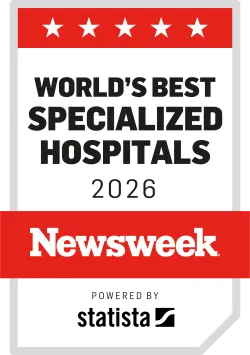Breadcrumb
- Home
- Conditions & Treatments
- KEBILIDI
What is KEBILIDI™ and how does it work?
KEBILIDI™ (eladocagene exuparvovec-tneq) is a gene therapy for children and adults that corrects a deficiency in the enzyme aromatic L-amino acid decarboxylase (AADC). It is the first approved gene therapy for AADC deficiency to be approved by the U.S. Food and Drug Administration (FDA) and the first approved gene therapy to be given directly into the brain.
AADC deficiency, caused by mutations in the DDC gene, is a rare and severe nervous system disorder. It impairs the brain’s ability to make neurotransmitters (chemical messengers) essential for multiple functions, specifically dopamine and serotonin. Untreated, AADC deficiency leads to gross motor impairments affecting head control, sitting, standing, and walking; dystonia; muscle weakness (hypotonia); autonomic symptoms ranging from nasal congestion to hypoglycemia; and developmental and cognitive delays.
KEBILIDI uses a modified, harmless virus, called an adeno-associated virus, to carry a healthy copy of the DDC gene into brain cells. The treatment is delivered by infusion into a precise region of the brain through a small hole in the skull during minimally invasive neurosurgery. After taking up the gene, the cells begin making a functioning AADC protein, enabling the brain to make neurotransmitters.
Boston Children’s has been designated as a Qualified Treatment Center for KEBILIDI treatment.
What benefits has KEBILIDI shown in studies?
Clinical studies, which are still ongoing, so far have shown that people receiving KEBILIDI are able to synthesize neurotransmitters and begin achieving motor and other developmental milestones.
A Phase 2 study at Boston Children’s Hospital and other centers, sponsored by the manufacturer, has been evaluating KEBILIDI in children 1 to 17 years old. Results reported so far are based on 13 patients ages 16 months to 10 years (average, 2.8 years), of whom 12 had severe AADC deficiency.
After 48 weeks of follow-up, three-quarters of the treated patients had achieved new gross motor milestones, including full head control, sitting with or without assistance, and walking. Younger patients tended to achieve more milestones. In a comparison group of 43 untreated children with severe AADC deficiency, none had achieved any motor milestones at their last assessment. Follow-up of the trial patients is expected to continue through 2028.
Other trials and compassionate use studies have had similarly promising results. They have also found improvements in cognitive abilities and language and significant reductions in the severity of oculogyric crises, a common complication of AADC, in which spasms in the eye muscles force the eyes to gaze to the side and upward.
Is KEBILIDI a cure?
It is too early to say for certain. However, because KEBILIDI corrects the root cause of AADC deficiency — a mutation in the DDC gene and inability to make key neurotransmitters — we hope it will enable children to achieve a longer life expectancy, more independence, and a better quality of life. We are encouraged by the clinical trial results so far, especially in younger children.
What is the treatment process with KEBILIDI?
Before KEBILIDI treatment, detailed brain imaging is performed to help the neurosurgical team plan the operation and pinpoint the target brain area. This area, known as the putamen, is deep in the brain and is where the AADC enzyme and dopamine signaling are most active. It is key to many motor and cognitive functions.
When it is time for treatment, your child will be admitted to the hospital on the day of surgery and will spend one or more nights in the hospital recovering. KEBILIDI is given through image-guided, minimally invasive neurosurgery under general anesthesia, in an operating room equipped to perform real-time magnetic resonance (MR) brain imaging.
A special navigation frame will be placed on your child’s head to allow the neurosurgical team to precisely target the brain in three dimensions. Under real-time imaging, special tubes called cannulas are guided into the putamen through two small holes made in the skull. KEBILIDI is then slowly infused into the putamen. In total there are four infusions, two per side of the brain in each putamen.
Postoperative care
After KEBILIDI treatment, your child will likely stay in the intensive care unit for about a day, and will then be transferred to Boston Children’s neuroscience unit for several days. Clinicians with expertise in AADC deficiency will monitor your child closely with lab evaluations and neurocognitive assessments. Care will also include physical therapy appointments to help your child maximize their motor skills.
Is KEBILIDI safe?
In clinical studies, the most common adverse reactions to KEBILIDI administration, reported in 15 percent or more of patients, have been as follows. These are temporary and can be addressed by our care team.
- Dyskinesia, or involuntary movements of the face, arm, leg, or entire body. This reaction can occur up to three months after the KEBILIDI infusion, and can be treated with anti-dopamine drugs. This reaction is actually a sign that the treatment is working.
- Fever
- Low blood pressure (hypotension)
- Anemia
- Increased production of saliva
- Insomnia
- Low blood levels of potassium, magnesium, or phosphate
The surgical procedure itself has very rare but more serious potential complications that your neurosurgical team will discuss with you in detail. Respiratory and cardiac arrest were reported in two of 13 treated patients. Other potential risks include leak of spinal fluid, bleeding in the brain, brain inflammation, and infection. Our neurosurgical and clinical teams will monitor for any signs of problems and are ready to act and treat immediately should they occur.
Who is eligible to receive KEBILIDI?
The FDA has approved KEBILIDI for both children and adults with AADC deficiency, at all levels of disease severity.
Children are eligible for KEBILIDI once their skull bones have fully matured. KEBILIDI is not being offered to pregnant teens and adults since it has not to date been proven safe in pregnancy.
KEBILIDI has not been studied to date in children under 16 months of age or adults over 65 years.
Will my health insurance cover KEBILIDI?
Because KEBILIDI has only recently become available, it’s not yet clear to what extent insurance providers will cover it. We encourage you to talk with your health insurance company and medical team. Boston Children’s Financial Services staff will guide you through the insurance approval process.


